With my main gear now sort of semi-fixed on rolling piers, the desire grew to have a true grab and go scope that I could take out to a dark site, the occasional star party, or on holiday. There are many options out there for small and very good scopes. But my attention was drawn to the Takahashi FS-60CB. The optical qualities of this scope are generally highly regarded, especially under visual observers. However there are not a lot of photographers out there that use this baby-Tak. I was lucky enough to get in contact with someone who used this scope for astrophotography and he was able to show some very impressive results. I was convinced it could be done, so started to put a system together. The most-heard complaint about these small Takahashi's for photography is the focuser. It is not designed to hold kilos of camera gear without sagging a bit. So I decided to replace the stock focuser with a PrimaluceLab Esatto 2" that I had used for another project some time ago. Primalucelab sells even an adapter specifically for the FS-60CB! As a camera I decided to go for the QHY268c aps-C sized OSC camera. To go from a Primalucelab focuser to a Takahashi flattener to a Baader filter drawer to a QHY camera takes a bit of puzzling to get the connections and distances right. But the puzzle is now complete. One of the benefits of the FS-60CB is that it is a modular system. There is a flattener, reducer and extender available. But also the objective lens can be replaced by a 76mm objective element. So that makes in total six scopes, ranging from 255mm @f/4.2 to 954mm @f12/6. It remains to be seen which of the combinations make the most sense, but to have the option to switch is nice. The newly released Askar V is doing something similar. In the current configuration I have the multi-flattener 1.04x installed for a 370mm @f/6.2 OTA. I'm planning to add the reducer as well. The scope rides on an RST-135E mount. This strain wave mount is extremely portable and has good performance. My preference for this mount is to not load it up with too heavy scopes or it can quickly become a bit unstable. This travel scope however sits extremely comfortable on this little mount. During a first light session there were still a couple of issues to be worked out, but I was able to get half an hour exposure of the Eagle Nebula. Even without flat calibration I was pleased with this initial result: https://www.astrobin.com/8dl7vg/The distances were not completely correct though, so I changed some of the adapters to get the backfocus better dialed in. This is the star field in a 60s exposure a few days later (for a full-resolution version, see here):  The image field was pretty flat and stars were round with a mean Eccentricity value of 0.47. No signs of strange aberrations, astigmatism, coma, etc. The camera is APS-C though, so not the most demanding. Theoretically the system should support a full frame camera as well. It remains to be seen how the system performs on full frame though.  Guiding was done using an Askar FMA180 with ASI290MM camera. Tracking worked well with RMS values typically in the range of 0.6-0.7" for RA and 0.4" for DEC. I'm powering the whole rig with USB-Power Delivery. A simple wall charger with four USB-PD ports is enough for the whole rig and can be used at home on the mains power as well as in the field on an GoalZero power station. This is how the setup looks in detail: 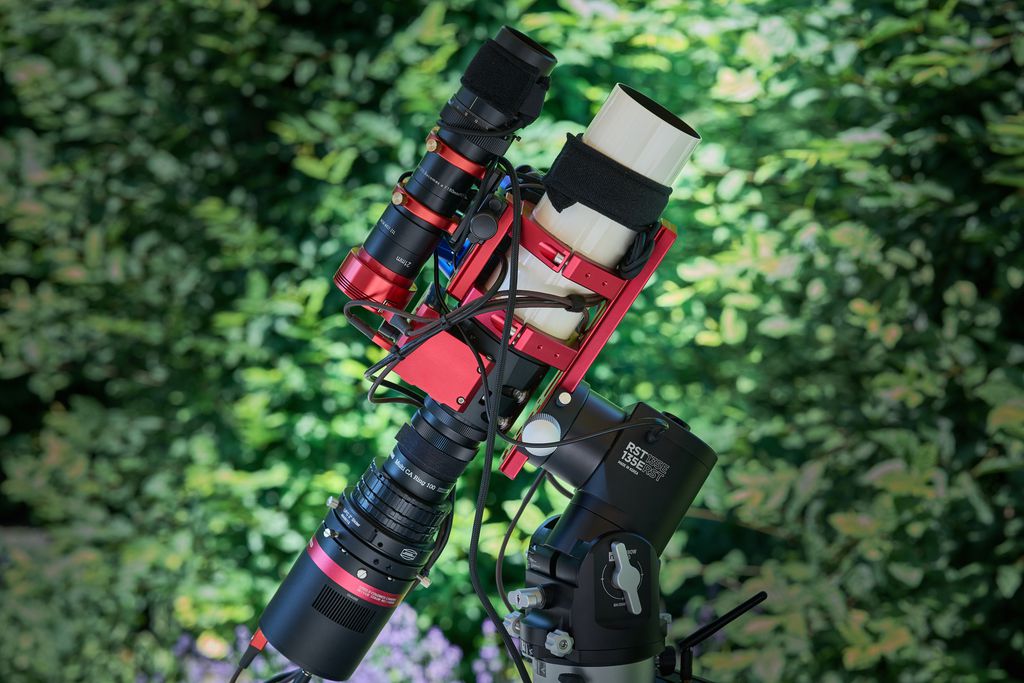 And this is the whole setup, on top of a Gitzo carbon tripod in the setup as it can be taken into the field: 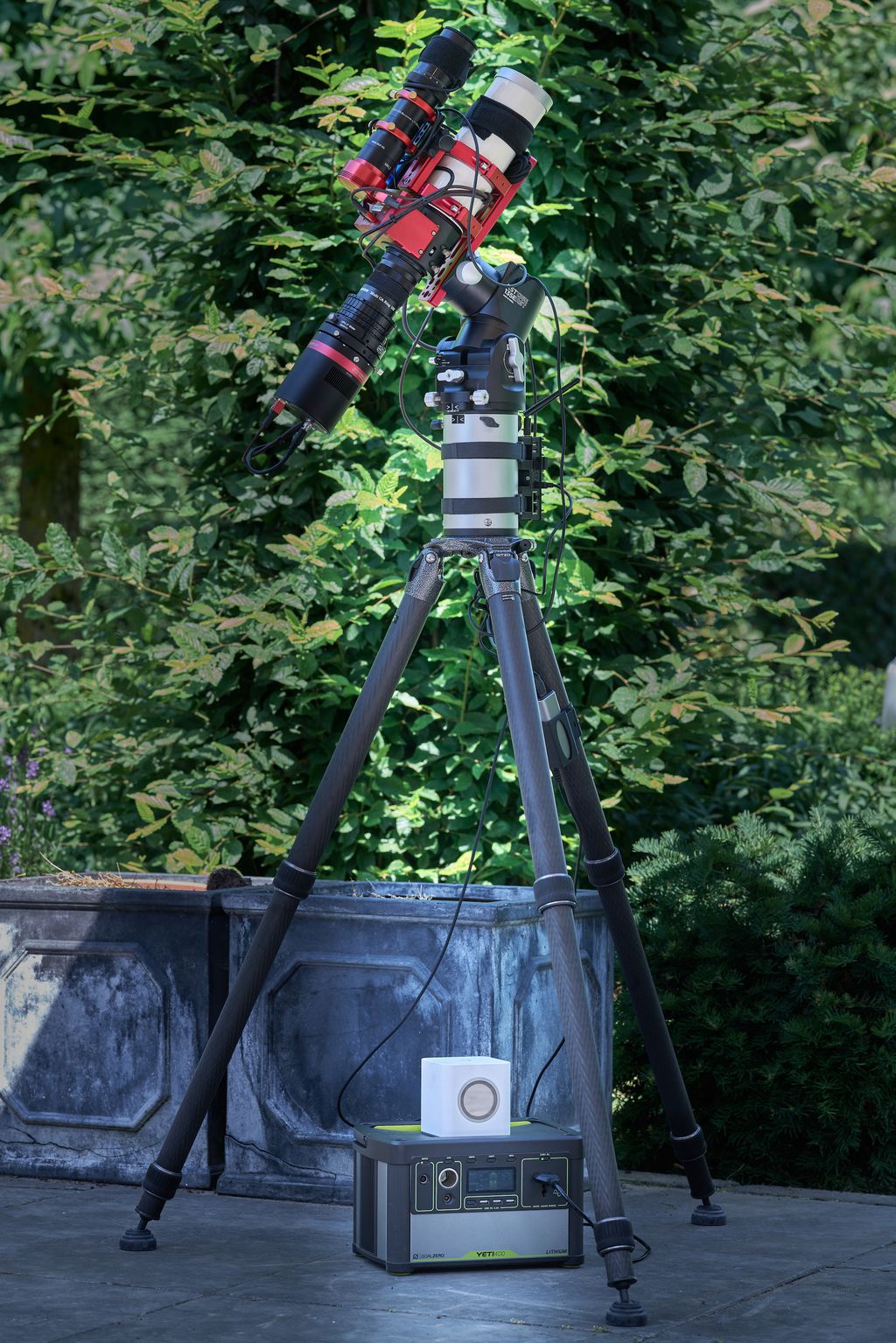 Initial experience is good. It is light, compact and easy to setup. The first results suggest a high optical quality. A variety of optical aids and the option to even put full frame cameras on it make it at least in theory a very versatile setup. I'm looking forward to take this little rig to some nice places and further explore its possibilities.
|
You cannot like this item. Reason: "ANONYMOUS".
You cannot remove your like from this item.
Editing a post is only allowed within 24 hours after creating it.
You cannot Like this post because the topic is closed.
Copy the URL below to share a direct link to this post.
This post cannot be edited using the classic forums editor.
To edit this post, please enable the "New forums experience" in your settings.
Just did a flatfield test as well. Used a 100mm Gerd Neumann flat panel for it, which is battery-operated. Running the FlatContourPlot in PixInsight shows that the imaging plane is pretty uniformly lit and light fall-off in the far corners is maximally 8.5%. 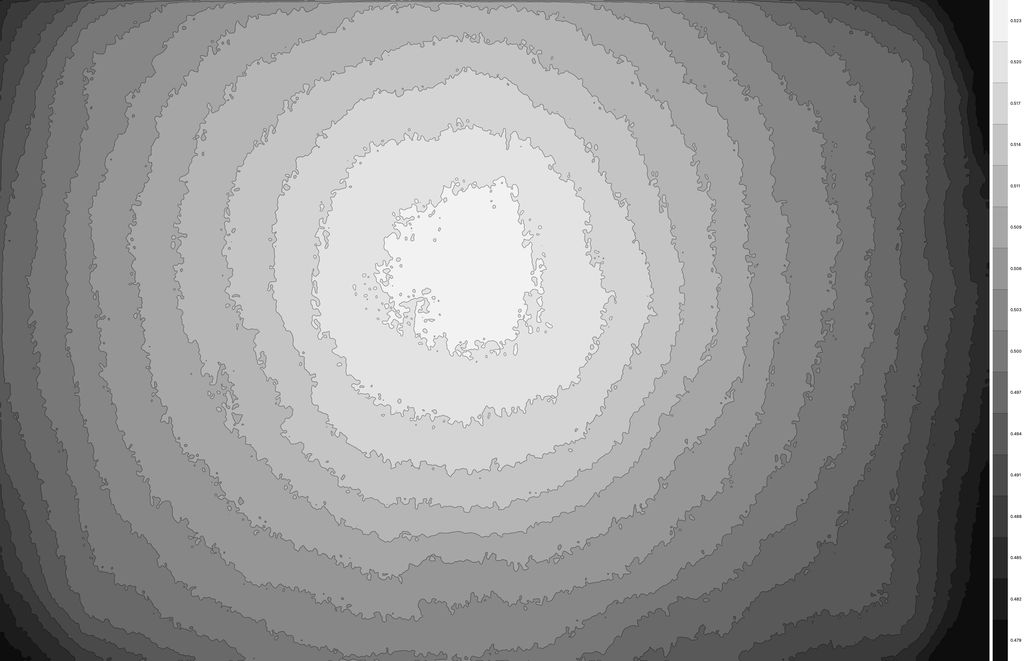 |
You cannot like this item. Reason: "ANONYMOUS".
You cannot remove your like from this item.
Editing a post is only allowed within 24 hours after creating it.
You cannot Like this post because the topic is closed.
Copy the URL below to share a direct link to this post.
This post cannot be edited using the classic forums editor.
To edit this post, please enable the "New forums experience" in your settings.
Thank you for posting this! I am also a big fan of the FS60CB for a grab-n-go imaging setup. As you say, it's modularity and small size make it very useful. I've used mine with a Tak PM-1 mount in a variety of configurations: with the reducer and a Fuji camera for "no big battery, no computer" widefield imaging travel setup, at its native focal length with a Quark and ZWO camera for solar, and even with the Q module for some lunar/planetary. I have also enjoyed using it for visual. I look forward to seeing your work with this scope!
|
You cannot like this item. Reason: "ANONYMOUS".
You cannot remove your like from this item.
Editing a post is only allowed within 24 hours after creating it.
You cannot Like this post because the topic is closed.
Copy the URL below to share a direct link to this post.
This post cannot be edited using the classic forums editor.
To edit this post, please enable the "New forums experience" in your settings.
Thanks Rob. I see you use the reducer a lot as well, with some excellent results! Are you happy with it? Have you ever considered the 76mm objective?
|
You cannot like this item. Reason: "ANONYMOUS".
You cannot remove your like from this item.
Editing a post is only allowed within 24 hours after creating it.
You cannot Like this post because the topic is closed.
Copy the URL below to share a direct link to this post.
This post cannot be edited using the classic forums editor.
To edit this post, please enable the "New forums experience" in your settings.
I am very happy with the scope in all the configurations I have tried. With the reducer, I have a very small reasonably fast scope I can use for widefield imaging on the Tak PM1 with no need for go-to or platesolve to find most targets. It is no FSQ (though mine was actually purchased as an FS-60Q with the Q-module), but does OK with sensors up to the size of the Fuji X-series cameras I usually use with it. I haven't used any of the PI analysis tools on the frames w/ the reducer - if I get a few minutes, I will try to do so and add to this thread if that would be helpful?
For the FS60, I have not yet purchased the flattener, as I went with the reducer for wider/faster which was better for my needs, but may do so just to have the complete range of options. I have heard that the 76mm is a great upgrade… suspect I will want to try it at some point, though if a bigger scope is needed I have my TSA102 on an EM-200 so haven't been able to justify it. Guess I should probably pull the trigger soon if I'm going to go for the flattener and/or the bigger objective, to make sure Tak doesn't change their lineup. I haven't looked recently to see if the 76mm objective is still available - are you planning on adding it? I would think it would work really well with your setup.
|
You cannot like this item. Reason: "ANONYMOUS".
You cannot remove your like from this item.
Editing a post is only allowed within 24 hours after creating it.
You cannot Like this post because the topic is closed.
Copy the URL below to share a direct link to this post.
This post cannot be edited using the classic forums editor.
To edit this post, please enable the "New forums experience" in your settings.
Thanks Rob, great to hear you have so much success with this setup. Please don't go to too much trouble, but an example of the reducer would be great. The fuji-X is also APS-C, so very comparable.
Good point on Tak changing their line-up…. Hadn't thought about that, but something to keep in mind. Right now the focus is on getting some experience with the current setup. I've bought the Antlia dual-band 5nm filter to get some narrowband as well. Longer term I was thinking of adding the reducer and the 76mm objective (kind of as an extender without too much loss in speed). The 76mm works with the same multi-flattener, so that's an easy swap.
You are right, as soon as you go longer there's probably other alternatives as well. But in my case that would mostly be home-based. The use of this setup is 'on the road', so the flexibility with an extra lens or two seems attractive.
|
You cannot like this item. Reason: "ANONYMOUS".
You cannot remove your like from this item.
Editing a post is only allowed within 24 hours after creating it.
You cannot Like this post because the topic is closed.
Copy the URL below to share a direct link to this post.
This post cannot be edited using the classic forums editor.
To edit this post, please enable the "New forums experience" in your settings.
@Willem Jan Drijfhout Hi, quick question. Is the Multi CA Ring 100 M54 or M52 on the camera side? I see conflicting data online.
|
You cannot like this item. Reason: "ANONYMOUS".
You cannot remove your like from this item.
Editing a post is only allowed within 24 hours after creating it.
You cannot Like this post because the topic is closed.
Copy the URL below to share a direct link to this post.
This post cannot be edited using the classic forums editor.
To edit this post, please enable the "New forums experience" in your settings.
@Willem Jan Drijfhout Hi, quick question. Is the Multi CA Ring 100 M54 or M52 on the camera side? I see conflicting data online. Camera-side is M54. Where does it state something different? I usually look at the Teleskop-Austria site. They usually have a lot of info on Tak products and reliable: Teleskop-Austria |
You cannot like this item. Reason: "ANONYMOUS".
You cannot remove your like from this item.
Editing a post is only allowed within 24 hours after creating it.
You cannot Like this post because the topic is closed.
Copy the URL below to share a direct link to this post.
This post cannot be edited using the classic forums editor.
To edit this post, please enable the "New forums experience" in your settings.
Willem Jan Drijfhout:
@Willem Jan Drijfhout Hi, quick question. Is the Multi CA Ring 100 M54 or M52 on the camera side? I see conflicting data online.
Camera-side is M54. Where does it state something different?
I usually look at the Teleskop-Austria site. They usually have a lot of info on Tak products and reliable: Teleskop-Austria Thank you, I went ahead and purchased it. The Multi Ring CA 60c and 76 actually state it is a M54 thread on Tak America’s chart, so I purchased them. Turns out they are M52, so not of any use to me. I should have checked other sources as well. I need M54 to into my camera t-ring. I wanted to confirm that the Multi Ring CA 100 was in fact M54 as stated.
|
You cannot like this item. Reason: "ANONYMOUS".
You cannot remove your like from this item.
Editing a post is only allowed within 24 hours after creating it.
You cannot Like this post because the topic is closed.
Copy the URL below to share a direct link to this post.
This post cannot be edited using the classic forums editor.
To edit this post, please enable the "New forums experience" in your settings.
Willem Jan Drijfhout:
@Willem Jan Drijfhout Hi, quick question. Is the Multi CA Ring 100 M54 or M52 on the camera side? I see conflicting data online.
Camera-side is M54. Where does it state something different?
I usually look at the Teleskop-Austria site. They usually have a lot of info on Tak products and reliable: Teleskop-Austria
Thank you, I went ahead and purchased it. The Multi Ring CA 60c and 76 actually state it is a M54 thread on Tak America’s chart, so I purchased them. Turns out they are M52, so not of any use to me. I should have checked other sources as well. I need M54 to into my camera t-ring. I wanted to confirm that the Multi Ring CA 100 was in fact M54 as stated.
Ah, I see! Indeed, the 76 has M52 on both ends…. I have to say I love Takahashi telescopes. And as long as you stick with all Tak components, it is fine. But as soon as you mix with other equipment, the dimensions of their connectors is often a headache. Btw, you know this I’m sure, but the 76 has a male connector on the camera side. The 100 has a female.
|
You cannot like this item. Reason: "ANONYMOUS".
You cannot remove your like from this item.
Editing a post is only allowed within 24 hours after creating it.
You cannot Like this post because the topic is closed.
Copy the URL below to share a direct link to this post.
This post cannot be edited using the classic forums editor.
To edit this post, please enable the "New forums experience" in your settings.
Hi Willem love your setup, I am building a similar one with a - TAK FC-100DZ (3.7kg) (which has a retractable shield, without focuser is 540mm stored) it comes with a 2" ready sturdy focuser and I am planning to use it on - my mixed bag mount iOptron Hem15 (hybrid strain wave drive mount) weights 2.5kg, - I have bought a full frame reducer FC-35 0.66x which makes it relatively fast at f/5.3 at 530mm I don't think using the flattener at native focus would be usable at f8 unless I get a master in autoguiding  Anyone else has a similar plan ? Best from Calabria, Italy Antonio ps: power station is the Bresser any good ?
|
You cannot like this item. Reason: "ANONYMOUS".
You cannot remove your like from this item.
Editing a post is only allowed within 24 hours after creating it.
You cannot Like this post because the topic is closed.
Copy the URL below to share a direct link to this post.
This post cannot be edited using the classic forums editor.
To edit this post, please enable the "New forums experience" in your settings.
Antonio Parisi:
Hi Willem love your setup, I am building a similar one with a
- TAK FC-100DZ (3.7kg) (which has a retractable shield, without focuser is 540mm stored) it comes with a 2" ready sturdy focuser and I am planning to use it on - my mixed bag mount iOptron Hem15 (hybrid strain wave drive mount) weights 2.5kg,
- I have bought a full frame reducer FC-35 0.66x which makes it relatively fast at f/5.3 at 530mm
I don't think using the flattener at native focus would be usable at f8 unless I get a master in autoguiding 
Anyone else has a similar plan ?
Best from Calabria, Italy
Antonio
ps: power station is the Bresser any good ? Thank you, Antonio. Your setup with the FC-100DZ looks very promising as well. When you say 540mm without focuser, does that mean that you take the focuser off when you put the scope in the bag? Looking forward to hear your experiences with it once ready. No experience with Bresser. I use the GoalZero Yeti. CS, Willem Jan.
|
You cannot like this item. Reason: "ANONYMOUS".
You cannot remove your like from this item.
Editing a post is only allowed within 24 hours after creating it.
You cannot Like this post because the topic is closed.
Copy the URL below to share a direct link to this post.
This post cannot be edited using the classic forums editor.
To edit this post, please enable the "New forums experience" in your settings.
You could potentially do it I have not done it yet because I am waiting for the scope.. it's a bit difficult to get one these days but they said 10 days, fingers crossed. I will have a look at the Yeti I have bought a usb to DC cable will try with that.
The only issue is that without autoguiding these strain wave mounts without encoders are unusable at least the iOptron ones. I need to sort a raspberry pi asap.
I will write a little post once done. For the next couple of days I Will try my Tamron 150-500 on the Orion Nebula let's see.
Best
Antonio
|
You cannot like this item. Reason: "ANONYMOUS".
You cannot remove your like from this item.
Editing a post is only allowed within 24 hours after creating it.
You cannot Like this post because the topic is closed.
Copy the URL below to share a direct link to this post.
This post cannot be edited using the classic forums editor.
To edit this post, please enable the "New forums experience" in your settings.
how much backfocus distance did you have from the end of the flattener to the sensor because takahashi said 87.5mm but people are saying its too much and it needs to be 55mm. So i could i please have your opinion?
thanks
ajneet
|
You cannot like this item. Reason: "ANONYMOUS".
You cannot remove your like from this item.
Editing a post is only allowed within 24 hours after creating it.
You cannot Like this post because the topic is closed.
Copy the URL below to share a direct link to this post.
This post cannot be edited using the classic forums editor.
To edit this post, please enable the "New forums experience" in your settings.
See below my imaging train. There is 88mm from the flattener to the sensor plane. This compensates 0.7mm for a 2mm filter in the light path, so the ‘clean’ backfocus distance is 87.3mm. 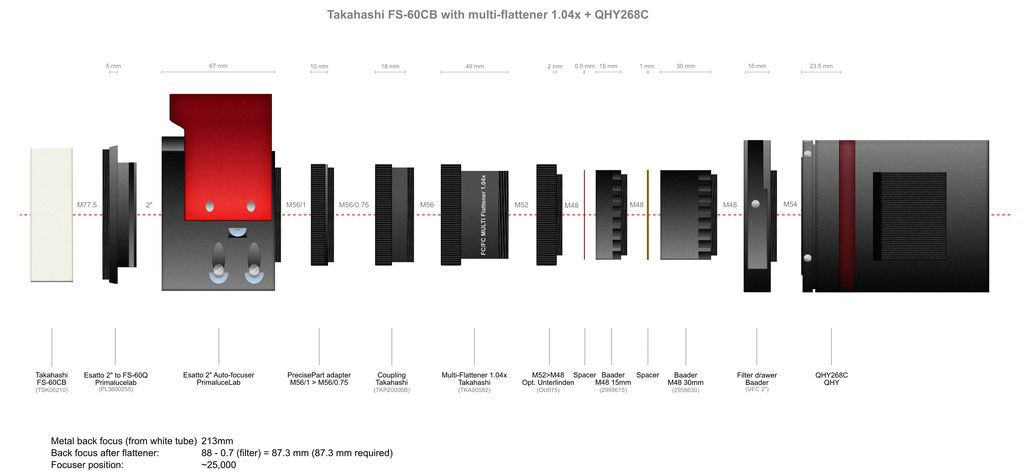 Perhaps the 55mm comes from the distance after the associated Multi CA ring? Takahashi states 87.5mm from flattener to sensor. But different scopes that use this flattener have different distances and Takahashi makes dedicated rings for each combination, to get to a standardized distance, which is likely 55mm.  Hope this helps. CS, Willem Jan
|
You cannot like this item. Reason: "ANONYMOUS".
You cannot remove your like from this item.
Editing a post is only allowed within 24 hours after creating it.
You cannot Like this post because the topic is closed.
Copy the URL below to share a direct link to this post.
This post cannot be edited using the classic forums editor.
To edit this post, please enable the "New forums experience" in your settings.
Thank you this helped.
one more question, could you please share what software you used to get that back focus diagram as i think it would make finding adapters and shims easier.
kind regards
Ajneet
|
You cannot like this item. Reason: "ANONYMOUS".
You cannot remove your like from this item.
Editing a post is only allowed within 24 hours after creating it.
You cannot Like this post because the topic is closed.
Copy the URL below to share a direct link to this post.
This post cannot be edited using the classic forums editor.
To edit this post, please enable the "New forums experience" in your settings.
Ajneet Singh:
Thank you this helped.
one more question, could you please share what software you used to get that back focus diagram as i think it would make finding adapters and shims easier.
kind regards
Ajneet I did create this in Affinity Designer, but I guess you could make this in any vector-based design software. CS, Willem Jan.
|
You cannot like this item. Reason: "ANONYMOUS".
You cannot remove your like from this item.
Editing a post is only allowed within 24 hours after creating it.
You cannot Like this post because the topic is closed.
Copy the URL below to share a direct link to this post.
This post cannot be edited using the classic forums editor.
To edit this post, please enable the "New forums experience" in your settings.
Willem Jan Drijfhout:
See below my imaging train. There is 88mm from the flattener to the sensor plane. This compensates 0.7mm for a 2mm filter in the light path, so the ‘clean’ backfocus distance is 87.3mm.
 Should 1/3 the thickness of the filter not be added to back focus after flattener, rather than subtracted?
|
You cannot like this item. Reason: "ANONYMOUS".
You cannot remove your like from this item.
Editing a post is only allowed within 24 hours after creating it.
You cannot Like this post because the topic is closed.
Copy the URL below to share a direct link to this post.
This post cannot be edited using the classic forums editor.
To edit this post, please enable the "New forums experience" in your settings.
Willem Jan Drijfhout:
See below my imaging train. There is 88mm from the flattener to the sensor plane. This compensates 0.7mm for a 2mm filter in the light path, so the ‘clean’ backfocus distance is 87.3mm.

Should 1/3 the thickness of the filter not be added to back focus after flattener, rather than subtracted?
Yes indeed, sorry, I may have written it a bit the other way around. Another way of saying the same is: The BF distance should be 87.5mm + 1/3*2mm = 88.167 mm. My actual distance as per the chart is 88mm.
|
You cannot like this item. Reason: "ANONYMOUS".
You cannot remove your like from this item.
Editing a post is only allowed within 24 hours after creating it.
You cannot Like this post because the topic is closed.
Copy the URL below to share a direct link to this post.
This post cannot be edited using the classic forums editor.
To edit this post, please enable the "New forums experience" in your settings.
Willem Jan Drijfhout:
The most-heard complaint about these small Takahashi's for photography is the focuser. It is not designed to hold kilos of camera gear without sagging a bit. So I decided to replace the stock focuser with a PrimaluceLab Esatto 2" that I had used for another project some time ago. Primalucelab sells even an adapter specifically for the FS-60CB! As a camera I decided to go for the QHY268c aps-C sized OSC camera. To go from a Primalucelab focuser to a Takahashi flattener to a Baader filter drawer to a QHY camera takes a bit of puzzling to get the connections and distances right. But the puzzle is now complete. Hello Willem Jan, Did you consciously choose the Primaluce focuser? Since you are very satisfied with this focuser. I have an Asiair plus. Now I don't know if it works with a Primaluce. Personally, I would also like to purchase one, because it is nicely integrated on the tube. instead of a ZWO-EAFhere Kind regards, Gio
|
You cannot like this item. Reason: "ANONYMOUS".
You cannot remove your like from this item.
Editing a post is only allowed within 24 hours after creating it.
You cannot Like this post because the topic is closed.
Copy the URL below to share a direct link to this post.
This post cannot be edited using the classic forums editor.
To edit this post, please enable the "New forums experience" in your settings.
Hello Gio,
No, the Primaluce focuser was not specifically chosen for this project. I bought it quite a while ago with the goal to automate focusing a Mewlon telescope. By the time I built up the FS-60CB rig, the Mewlon was mainly used for lunar/planetary and did not really need autofocus, so re-purposing the Esatto for the FS-60CB seemed like a better choice. The benefit of the Esatto over a focus motor, like the EAF, is that it can hold a quite heavy imaging train. The capacity is in the order of 5kg or so I believe. The standard Tak focuser is fairly small and the imaging train with flattener stands out quite a bit, so not sure how well that holds. The replacement of the FS-60CB (FCT-65D) has a bigger/improved focuser.
Primalucelab focusers are not supported by ASI Air. Unfortunately the ASI Air restricts hardware use to ZWO products only, with the exception of mounts and DSLR's. So I'm afraid that if you want to keep using ASI Air, you will have to use the EAF, and if you prefer another focuser, you will have to choose other imaging software. ASI Air originates from KStars/Ekos, so you may want to check that out, or Stellarmate, which is the 'ASI Air-version' of it. Or you could go the NINA route with a small headless PC and power distribution device (Pegasus for example).
Hope this helps.
CS, Willem Jan.
|
You cannot like this item. Reason: "ANONYMOUS".
You cannot remove your like from this item.
Editing a post is only allowed within 24 hours after creating it.
You cannot Like this post because the topic is closed.
Copy the URL below to share a direct link to this post.
This post cannot be edited using the classic forums editor.
To edit this post, please enable the "New forums experience" in your settings.
Da Willem Jan Drijfhout:
Primalucelab focusers worden niet ondersteund door ASI Air. Helaas beperkt ASI Air het hardwaregebruik tot ZWO producten Thanks for the explanation Willem Jan. Then I will stick to the EAF vn ZWO. At least for now. 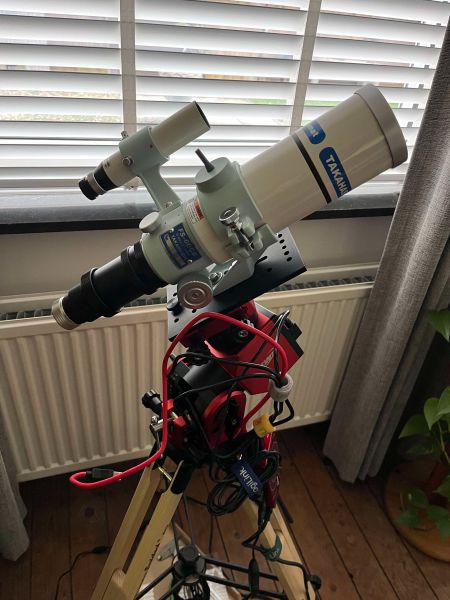 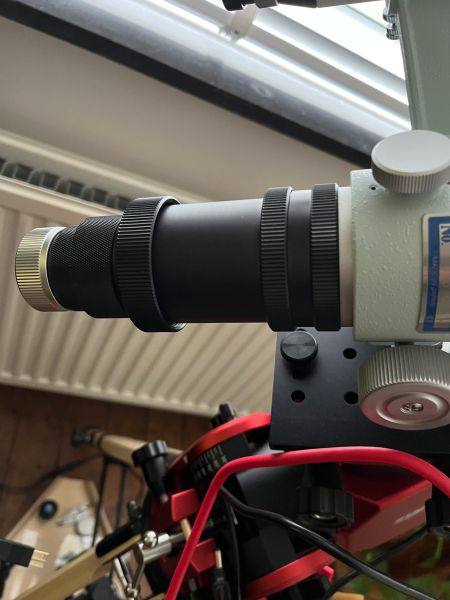 I also own a Tak myself. FS60CB. I still have to get it ready for use. what strikes me is that Takahashi uses unusual sizes when it comes to adapters. for example, they differ by only 1mm the standard sizes. I plan to install the following parts: - Takahashi focal reducer 0.72 - ZWO Off-Axis Guide - ZWO Filter Drawer That will be quite a challenge to find the right adapters for that isue... Kind regards, Gio
|
You cannot like this item. Reason: "ANONYMOUS".
You cannot remove your like from this item.
Editing a post is only allowed within 24 hours after creating it.
You cannot Like this post because the topic is closed.
Copy the URL below to share a direct link to this post.
This post cannot be edited using the classic forums editor.
To edit this post, please enable the "New forums experience" in your settings.
I still have to get it ready for use. what strikes me is that Takahashi
uses unusual sizes when it comes to adapters. for example, they differ by only 1mm
the standard sizes. I plan to install the following parts: Yes, that is a typical Takahashi-thing. The good news is that they publish quite detailed system charts, so that you know the required distances. And the other bit of good news is that because Takahashi is such a well known brand, many retailers have some Takahashi-specific adapters in their portfolio. For example Optique-Underlinden (European distributor for Tak) sells this M52 > M48 adapter. Perfect for your reducer (M52) and only 2mm optical length. Once you're at standard M48, things get a lot easier. Another tip if you have to design Takahashi imaging trains is the website of Teleskop-Austria. In the description of almost all Takahashi parts that they're selling, the publish the optical length and thread-size on both sides. There are not many retailers that have such detailed info. Nice scope, and good luck with getting it properly installed! Looking forward to seeing the images coming out of it. CS, Willem Jan.
|
You cannot like this item. Reason: "ANONYMOUS".
You cannot remove your like from this item.
Editing a post is only allowed within 24 hours after creating it.
You cannot Like this post because the topic is closed.
Copy the URL below to share a direct link to this post.
This post cannot be edited using the classic forums editor.
To edit this post, please enable the "New forums experience" in your settings.
Thank you Willem Jan for this very useful information.
Tak's system charts are not always clear, because everything is specified around Tak.
Unfortunately, a fellow astronomer who is quite experienced could not help me because he finds it very complex.
I know a certain Rob Lefeber who is from Robotics (Leidschendam), he is a retailer of Tak and he also knows quite a lot,
but unfortunately it takes quite a long time to get an answer because a lot has to be asked and researched..
Anyway thanks again Willem Jan! I'll start looking immediately…..
Kind regards,
Gio
|
You cannot like this item. Reason: "ANONYMOUS".
You cannot remove your like from this item.
Editing a post is only allowed within 24 hours after creating it.
You cannot Like this post because the topic is closed.
Copy the URL below to share a direct link to this post.
This post cannot be edited using the classic forums editor.
To edit this post, please enable the "New forums experience" in your settings.
Hi Gio,
If you let me know how you would like your imaging train to look like, I’m happy to try and see if I can find you a solution with adapters etc. Feel free to send me a DM here on Astrobin.
CS, Willem Jan
|
You cannot like this item. Reason: "ANONYMOUS".
You cannot remove your like from this item.
Editing a post is only allowed within 24 hours after creating it.
You cannot Like this post because the topic is closed.
Copy the URL below to share a direct link to this post.
This post cannot be edited using the classic forums editor.
To edit this post, please enable the "New forums experience" in your settings.











